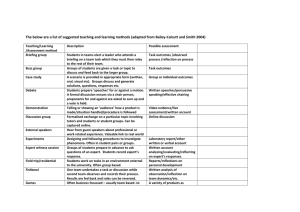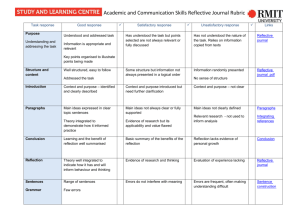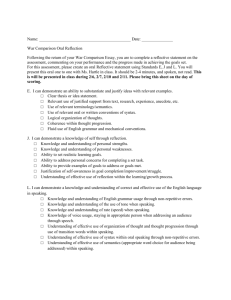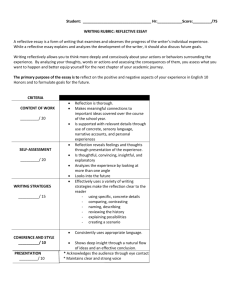Reflective practice - Careers & Employability
advertisement
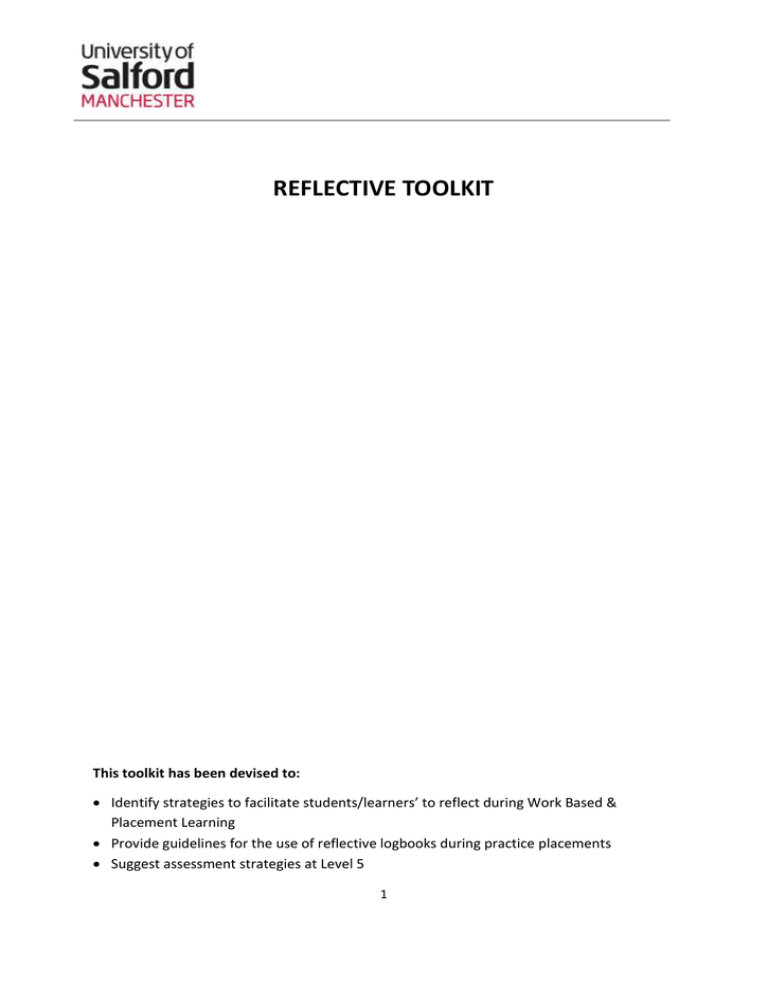
REFLECTIVE TOOLKIT This toolkit has been devised to: Identify strategies to facilitate students/learners’ to reflect during Work Based & Placement Learning Provide guidelines for the use of reflective logbooks during practice placements Suggest assessment strategies at Level 5 1 What is Reflection? The image of looking at oneself in a mirror, suggested by the word, means that it has implications of being conscious of what one is doing. Because of this it is a word that is widely used but not always understood. Rowntree (1988), for example, praises the reflective student who thinks about their own experience of studying and decides what changes of approach might be most suitable. Rowntree (1988) says reflection is studying one's own study methods as seriously as one studies the subject and thinking about a learning task after you have done it. Unless you do this, he says, the task will almost certainly be wasted. In any learning situation, he says, you should prepare for it beforehand, participate actively during it, and reflect on it afterwards. It is important, therefore, that reflection is on what is happening in the workplace and why the learning is different or unique because it is happening in the workplace. Becoming a Reflective Practitioner The exercise of completing a reflective journal promotes both the qualities required for reflection, i.e. Open mindedness and motivation and also the skills i.e. Self-awareness; description and observation; critical analysis and problem-solving; and synthesis and evaluation (Richardson & Maltby, 1995). According to the educator Professor David Boud, effective learning will not occur unless you reflect. To do this, you must think of a particular moment in time, ponder over it, go back through it and only then will you gain new insights into different aspects of that situation. Eventually you will probably come up with ideas for approaching the situation differently next time. You will then try out your ideas to see if they are effective. He/she will thus complete the learning cycle and start over again with a view to refining your actions. This is an ongoing process, so we will never achieve perfection. We will always find other ways of doing things based on our learning from previous experiences. Building up experience is a gradual process. You will develop reflective abilities during the course of their learning on placement. Reflection should initially develop in safe environments where mistakes are tolerated. Reflect and discuss the decisions that were made during your supervision sessions with your work-based supervisor or line manager. Reflection should become integral to these sessions. 2 Kolb’s Learning Cycle (Kolb 1984) CONCRETE EXPERIENCE Concerned with something that has happened to you or that you have done. Concerned with adopting your new ideas into practice. REFLECTIVE Concerned with reviewing the event or experience in your mind and exploring what you did and how you, and others, felt about it. ACTIVE EXPERIMENTATION Concerned with trying out the new ideas as a result of the learning from earlier experience and reflection. ABSTRACT CONCEPTUALISATION Concerned with developing an understanding of what happened by seeking more information and forming new ideas about ways of doing things in the future. Developing reflective practice Some students may initially have difficulty in understanding the value or purpose of the reflective process or the strategies used to facilitate reflection. The use of journal writing involving narrative description of tasks and reflective writing can be an effective reflective practice tool, although initial comments are often rambling, superficial and focused on cataloguing activities. It often takes the student a period of time to become introspective and reflect on current experiences (Van Gyn, 1996). 3 One strategy is the use of trigger questions to guide you is: • • • • What were the objectives? What were the outcomes? What went well? Less well? What will I do differently next time? Another strategy is to suggest the use of a reflective model or in the next framework. Models of Reflection (Boud et al 1985, Johns 1995) Stage 1: Return to experience Describe the experience, recollect what happened. Notice what happened / how you felt / what you did Stage 2: Attend to feelings Acknowledge negative feelings but don’t let them form a barrier Work with positive outcomes Stage 3: Re-evaluate the experience Connect ideas and feelings of the experience to those you had on reflection Consider options and choices Stage 4: Learning (Added by Johns 1995) How do I feel about this experience? Could I have dealt better with the situation? What have I learnt from this experience? Boud, D.; Keogh, R.; Walker, D. (Eds) (1985) Reflection: turning experience into learning. London: Kogan Page Johns, C. (1995) Framing learning through reflection within Carper’s fundamental ways of knowing in nursing. Journal of Advanced Nursing 22(2) 226-234 It is worth bearing in mind three points when looking at this model. 1. 'Returning to experience', is not as straight forward as some would have us believe. Experience isn't simply a sensation - it also entails thinking. We have to know that we have 'had an experience'. Thus, Boud et al (1993) argue that 'experience has within it judgment, thought and connectedness with other experience'. What is more; what we 4 return to changes. Our memories of a situation alter over time, and according to the mood we are in when we are recalling some event or experience. 2. One of the strengths of this way of viewing reflection is that it brings in feelings. Connecting with our emotions at a particular moment (in the past or now) and encouraging others to do so is not easy and is fraught with problems. 3. We also have to remember that it is people who are ‘returning’ This way of approaching reflection has the advantage of connecting with common modes of working e.g. we are often encouraged to attend to these domains in the process of supervision and journal writing. Gibbs’ Model of Reflection Gibbs’ reflective cycle encourages students to think systematically about the phases of an experience or activity, and you should use all the headings to structure your reflection. 1. Context: What has happened? Briefly describe the event as objectively, accurately and concisely as you can. Who was involved? Where did it happen? Do you intend to focus on the structure, process or outcomes? 2. Feelings: What were your feelings or emotions, both positive and negative..? ...at the time? ...afterwards? 3. Evaluation: How well did things go? Were things satisfactorily resolved? 4. Analyse: What were the factors that affected the outcome? What helped and what hindered? Can you explain the event? Why did it happen? How did it happen? 5. Conclusion: What might have been some alternative actions or approaches? What might you have done differently (even when things went well)? Could negative events be avoided? Could positive events be made more effective? 6. Future action: What will you do if you encounter this kind of situation again? What will you do in the future to increase the likelihood of similar positive outcomes and minimise the likelihood of similar negative outcomes? 5 What do you need to learn? How might you learn this? Gibbs, G. (1988) Learning by Doing: a guide to teaching and learning methods. Oxford. Further Education Unit. Reflective Logbooks A Reflective Logbook allows the student to document and analyse the situations, activities and relationships that they experience while in a Work Based & Placement Learning Environment. Generally speaking what distinguishes a learning logbook from other writing is that it focuses on on-going issues over time and there will be some intention to learn from either the process of doing it or from the results of it. For deeper learning and effective development the reflective logbook should not be a descriptive events diary. A Reflective Logbook is: Diverse. Not necessarily written - but most of the time assume written format. Generally reflective and accumulated over a period of time with the intention to learn, i.e. Not purely descriptive. Something that accentuates favourable conditions for learning e.g. space, time, reflection. Applicable to all disciplines. Eighteen purposes for logbook writing. (Moon, 1999). The 18 purposes listed by Moon are all vital for a student to gain a positive and rewarding developmental experience while in a Work Based & Placement Learning environment and to continue their theoretical and practical learning beyond. The eighteen purposes are: • To record experience • To facilitate learning from experience • To support understanding and the representation of that understanding • To develop critical thinking or the development of a questioning attitude • To encourage metacognition • To increase active involvement in, and ownership of, learning • To increase ability in reflection and thinking • To enhance problem solving skills • As a means of assessment in formal education • To enhance reflective practice • For reasons of personal development and self-empowerment • For therapeutic purposes or as means of supporting behaviour change • To enhance creativity • To improve writing 6 • • • • To improve or give 'voice'; as a means of self-expression To foster communication; in particular reflective and creative interaction within a group To support planning and progress in research or a project As a means of communication between one learner and another It is important that students are able to feel an element of freedom in what to include in their logbooks. They are a personal reflection tool and therefore photographs, drawings, mind-maps, free writing, newspaper clippings etc. can support the reflective learning process. To be able to better assess the reflective logbook especially with limited resources a structured approach to reflection is required. The DIEP four step approach (adapted from Boud, D 1985, Reflection: Turning Experience into Learning) are to describe, interpret, evaluate and plan allows the student the freedom to express within a structured framework. The three critical stages of reflection the reflective logbook will use the DIEP four step approach: D – Describe objectively what happened Give the details of what happened. Answer the question: ‘What did I do, read, see, and hear?’ I – Interpret the events Explain your learning: new insights, connections with other learning, your feelings, hypotheses, conclusions. Answer the questions: ‘What was the reason I did this activity?’ ‘What might it mean?’ E – Evaluate what you learned Make judgments connected to observations you have made. Answer the question: ‘How was this useful?’ P – Plan how this learning will be applied Comment on its relevance to your course, program, future profession, life... Answer the question: ‘How might this learning apply in my future?’ The Assessment of Reflective Writing There are many who argue that logbooks and reflective writing should not be assessed. This comment from convinced proponent of logbooks sums up some of the issues. 'How can you mark an individual's own personal development? I think it's a right and proper part of education for us to encourage students to express their feelings so that they know it's alright to have those feelings. However, for me to mark those feelings seems inconsistent and incongruent. Marks can also create a barrier or obstacle to the person finding his or her own voice…'(Sister Craig cited in Dillon, 1983) The first question to be asked in assessing journals is whether we are looking to assess the process of reflection or the product of learning. It is very important to remember that assessing journals has an effect on the manner in which the journal is written because students will try to write what they think is required. 7 Assuming that it is the reflection that is important, some general criteria can helpfully indicate adequacy. A list might include: Length, Presentation and legibility, Number of entries or regularity of entries; Clarity and good observation in presentation of events or issues; Evidence of speculation; Evidence of a willingness to revise ideas; Honesty and self-assessment; Thoroughness of reflection and self-awareness; Depth and detail of reflective accounts; Evidence of creative thinking; Evidence of critical thinking; Evidence of a deep approach to the subject matter of the journal Representation of different cognitive skills (synthesis, analysis, evaluation etc.); Relationship of the entries in the journal to any relevant coursework, theories etc. Match of the content and outcomes of the journal work to course objectives, Learning outcomes for the journal or purposes that the journal is intended to fulfil. Questions that arise from the reflective processes and on which to reflect further The framework below is generic and can be used to clarify the assessment of reflection within WBPL and take away the subjective element of assessing a student. Descriptive writing: This is a description of events or literature reports. There is no discussion beyond description. This writing is considered not to show evidence of reflection. It is important to acknowledge that some parts of a reflective account will need to describe the context but in this case; writing does not go beyond description. Descriptive reflection: There is basically a description of events, but the account shows some evidence of deeper consideration in relatively descriptive language. There is no real evidence of the notion of alternative viewpoints in use. Dialogic reflection: This writing suggests that there is a 'stepping back' from the events and actions which leads to a different level of discourse. There is a sense of 'mulling about', discourse with self and an exploration of the role of self in events and actions. There is consideration of the qualities of judgements and of possible alternatives for explaining and hypothesising. The reflection is analytical or integrative, linking factors and perspectives. Critical reflection: This form of reflection, in addition to dialogic reflection, shows evidence that the learner is aware that the same actions and events may be seen in different contexts with different explanations associated with the contexts. They are influenced by 'multiple historical and socio-political contexts', for example. (Hatton and Smith, 1995). 8 With a framework for the process of reflective writing and taking the literature of reflection into account, it is possible to consider development of criteria for assessment purposes. It also becomes possible to show students why just descriptive work is not 'reflective' in that it only covers a small part of the overall process of assessment indicators for reflective writing Purpose The learner demonstrates: Awareness and understanding of the purpose of the journal, using the purpose to guide selection and description of event / issue on which to reflect. The learner identifies: Her or his own purpose for the journal or journal entry. The description of an event or issue The description: Provides an adequate focus for further reflection; It includes: A statement of observations- comment on personal behaviour; Comment on reaction / feelings; Comment on context. Additional ideas Are present. The learner demonstrates: The introduction of (any) additional ideas to the description; The addition of Further observations; Relevant other knowledge, experience, feelings, intuitions Suggestions from others;- new information; Formal theory; Other factors such as ethical, moral, socio-political context. Reflective thinking Is present. The learner demonstrates: The ability to work with unstructured material The linking of theory and practice; The viewing of an issue / event from different points of view; The ability to 'step back' from a situation; • Metacognitive processes; • 'Cognitive housekeeping'; • Application of theoretical ideas; 9 • Considerations of alternative interpretations; etc. Other processing There is evidence of other processing - e.g. • New ideas are tested in practice; • New ideas are represented, for example, in a first draft or graphic form etc. and there is Evidence of review and revision in a later copy. A product results There is a statement of: Either • Something that has been learned or solved that relates to the purpose or the problematic nature of the description Or • There is a sense of moving on. For example, there is identification of a new area for further reflection or a new question is framed. Useful Resources within the University The Study Skills Team – Student Life The Study Skills Team provides opportunities for all students, regardless of experience or knowledge, to learn about different approaches and techniques to improve Reflective Writing including: • Online and print versions of their Study Basics Guide: Reflective Writing • Workshops – each semester Reflecting Writing workshops are held on both campuses • Bespoke sessions – on request from tutors – Reflective writing tailored to specific programme requirements • One to one advice on writing reflectively For more information go to: http://www.careers.salford.ac.uk/studyskills Careers and Employability – Student Life The Career Development and Employment Team a Work Experience Consultant and Careers Consultants who will be available to support and train students on a range of Work Based and Placement Learning initiatives. The Library Has a range of books related to Reflective Writing for both Academics and Students. 10
